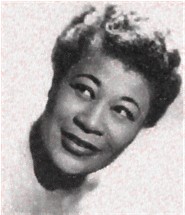Ella

"The Fitzgerald persona communicates as pure and humble, and most of her peers rate her as their favorite singer." -- Linda Dahl.
Die-hard pure jazz aficionados tend to place Billie Holiday on a higher plane than Ella Fitzgerald: while Billie’s singing was raw, intense and rhythmically sophisticated, Ella possessed qualities which are sometimes undervalued in the jazz world -- superb diction, a bell-like tone, and a jaunty, youthful, light touch. Pure jazz fans aside, Fitzgerald emerged by the end of the 20th century as one of the definitive jazz singers (or pop singers, if you prefer), charming and immediately accessible, and was surely the queen of be-bop, entrancing audiences by revitalizing the old form of "scatting" used so well by Louis Armstrong in the 1920s within the idiom of bop.
Born on this day in 1917 in Newport News, Virginia and orphaned at 15, Fitzgerald moved in with an aunt in New York City and cultivated dreams of some kind of stardom. Though shy and somewhat hulking and awkward, while still a teenager she entered a talent show hoping to dance her way to the prize, but she changed her mind at the last minute and tried singing. The episode was not a success, but she continue to pursue singing, and in 1934 she won an amateur contest at the Apollo Theater in Harlem singing "Judy" in the style of her idol, Connee Boswell. Friends finally convinced drummer/bandleader Chick Webb to take her on as his protégé ("Listen to the voice, don’t look at her," was how he convinced his own manager of the project), becoming her legal guardian (she was living in an orphanage at the time) and her professional mentor, honing her craft and even taking charge of her wardrobe.
Within a short period of time, Fitzgerald became a hit at the Savoy Hotel and began recording with Webb on Decca, making such sides as "I’ll Chase the Blues Away" and "Sing Me a Swing Song and Let Me Dance," principally for the dance audience. In 1938 she recorded the swinging "A-Tisket, A-Tasket" (on which she co-wrote the lyrics) which became a huge smash hit. Webb died in 1939, and Fitzgerald became the nominal bandleader until 1941, when she decided to go solo.
Although she could have rested on her laurels as a dance band vocalist with a string of commercial hits, with the advent of bop she stretched herself artistically, honing her improvisational skills on tour with Dizzy Gillespie, and by the 1950s she was an accomplished scat-singer ("her scatting was . . . a revelation" -- according to Dahl), with mesmerizing renditions of "Lady Be Good," "Flying Home" and "How High the Moon."
In 1955, she appeared in a Hollywood movie, Pete Kelly’s Blues (directed by and starring Jack Webb) and then signed on with Verve Records to begin recording her most memorable works, a series of "Songbook" albums featuring top-shelf popular songs by such songwriters as Cole Porter (1956), Duke Ellington (1956-57), Rodgers and Hart (1957), Irving Berlin (1958) and George and Ira Gershwin (1958-59). Other remarkable recordings during the 1950s and 1960s included her live, improvised rendition of "Mack the Knife" and the classic live album, Ella in Berlin (1960).
In the 1970s, she had eye surgery, which slowed her down, but with the initiation of Pablo Records in 1971, she turned it up again, recording splendid jazz albums with Joe Pass, Oscar Peterson and Count Basie. She also lent her voice and image to an oft-imitated TV commercial for Memorex audio tape, scatting to a high-note climax which shattered a wine glass before the off-screen announcer asked, "Is it live, or is it Memorex?" She died on June 15, 1996 in Beverly Hills, California at the age of 78, having all but retired during the 1980s due to eye and heart problems associated with diabetes.
Labels: Classic Pop Music, Jazz





0 Comments:
Post a Comment
Subscribe to Post Comments [Atom]
<< Home